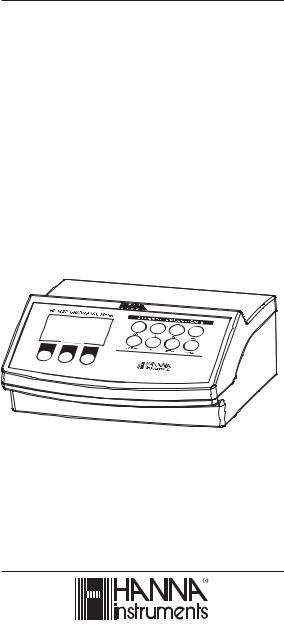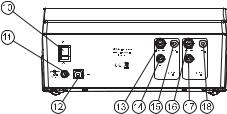Hanna Instruments HI 3220 User Manual

Instruction Manual
HI 3220 HI 3221
HI 3222
Calibration Check pH/mV/ISE/Temperature Bench Meters
www.hannainst.com
1

Dear Customer,
Thank you for choosing a Hanna Instruments product.
Please read this instruction manual carefully before using the instruments.
This manual will provide you with the necessary information for correct use of the instruments, as well as a precise idea of their versatility.
If you need additional technical information, do not hesitate to e-mail us at tech@hannainst.com or turn to the back cover for our worldwide contact list.
These instruments are in compliance with 
 directives.
directives.
WARRANTY
The HI 322x series are guaranteed for two years against defects in workmanship and materials when used for their intended purpose and maintained according to instructions. Electrodes and probes are guaranteed for six months. This warranty is limited to repair or replacement free of charge.
Damage due to accidents, misuse, tampering or lack of prescribed maintenance is not covered.
If service is required, contact the dealer from whom you purchased the instrument. If under warranty, report the model number, date of purchase, serial number and the nature of the problem. If the repair is not covered by the warranty, you will be notified of the charges incurred. If the instrument is to be returned to Hanna Instruments, first obtain a Returned Goods Authorization number from the Technical Service department and then send it with shipping costs prepaid. When shipping any instrument, make sure it is properly packed for complete protection.
TABLE OF CONTENTS |
|
WARRANTY .......................................................................................................................................... |
2 |
PRELIMINARY EXAMINATION ................................................................................................................. |
3 |
GENERAL DESCRIPTION ......................................................................................................................... |
3 |
HI 3220, HI 3221 FUNCTIONAL DESCRIPTION ......................................................................................... |
5 |
HI 3222 FUNCTIONAL DESCRIPTION ...................................................................................................... |
6 |
HI 3220 SPECIFICATIONS ...................................................................................................................... |
8 |
HI 3221 SPECIFICATIONS ...................................................................................................................... |
9 |
HI 3222 SPECIFICATIONS .................................................................................................................... |
10 |
OPERATIONAL GUIDE ......................................................................................................................... |
11 |
pH CALIBRATION ............................................................................................................................... |
15 |
pH BUFFER TEMPERATURE DEPENDENCE .............................................................................................. |
23 |
RELATIVE mV CALIBRATION ................................................................................................................ |
24 |
ISE CALIBRATION HI 3221 AND HI 3222 ............................................................................................... |
25 |
GOOD LABORATORY PRACTICE (GLP) ..................................................................................................... |
29 |
SETUP .............................................................................................................................................. |
31 |
LOGGING ........................................................................................................................................... |
43 |
mV AND TEMPERATURE CALIBRATION (for technical personnel only) ........................................................ |
46 |
PC INTERFACE ................................................................................................................................... |
49 |
TEMPERATURE CORRELATION FOR pH SENSITIVE GLASS .......................................................................... |
56 |
ELECTRODE CONDITIONING & MAINTENANCE ....................................................................................... |
57 |
TROUBLESHOOTING GUIDE ................................................................................................................ |
60 |
ACCESSORIES .................................................................................................................................... |
61 |
2

PRELIMINARY EXAMINATION
Remove the instrument from the packing material and examine it carefully to make sure that no damage has occurred during shipping. If there is any damage, notify your Dealer or the nearest Hanna Customer Service Center.
Each instrument is supplied with:
•HI1131B Glass body combination double-junction pH electrode
•HI 7662-T stainless steel Temperature Probe with 1 m (3.3') Cable
•pH 4.01 & 7.01 Buffer Solutions (20 mL each)
•HI 700661 Cleaning solution (2x20 mL each)
•HI 7071S Electrolyte Solution
•HI 76404N Electrode Holder
•12 Vdc Power Adaptor
•Instruction Manual
HI 322x are supplied with 12 Vdc/230 Vac power adapter HI 322x-01 are supplied with 12 Vdc/115 Vac power adapter
Note: Save all packing material until you are sure that the instrument functions correctly. All defective items must be returned in the original packing with the accessories supplied.
GENERAL DESCRIPTION
The HI 322x instruments are state-of-the-art, professional bench pH meters with graphical LCD, designed to provide laboratory results and accuracy. They are provided with a series of new diagnostic features which add an entirely new dimension to the measurement of pH, by allowing the user to dramatically improve the reliability of the measurement:
•Single (HI 3220 and HI 3221) or dual (HI 3222) input channels
•7 standard pH buffers (pH 1.68, 4.01, 6.86, 7.01, 9.18, 10.01 and 12.45) for calibration.
•pH calibration up to five calibration points (see instrument specifications).
•Custom calibration with up to five custom buffers.
•Messages on the graphic LCD for an easy and accurate calibration.
•Diagnostic features to alert the user when the electrode needs cleaning.
•User selectable “Outside Calibration Range” warning.
•User-selectable “Calibration Time Out” to remind when a new calibration is necessary.
Hanna Instruments reserves the right to modify the design, construction and appearance of its products without advance notice.
3
Moreover, they offer an extended temperature range from –20 to 120 ºC (–4 to 248 ºF), using HI 7662-T interchangeable temperature probes. These instruments can also measure with ORP electrodes, thanks to their capability to measure mV with a resolution up to 0.1 mV.
HI 3221 and HI 3222 can also measure with ISE electrodes on ppm scale. The electrode type and unit selection capability (for HI 3222), the ion change selection capability (for HI 3221) and the ISE calibration in up to five calibration standard solutions make this instrument very useful for a large range of concentration solutions measurements.
Other features include:
•Relative mV measurements
•Log on demand up to 400 samples
•Log interval with log on stability feature up to 600 records
•Auto Hold feature, to freeze first stable reading on the LCD
•GLP feature, to view last calibration data for pH, Rel mV or ISE
•PC interface
4

HI 3220, HI 3221
FUNCTIONAL DESCRIPTION
Front view
1)Liquid Crystal Display (LCD)
2)Function keys
3)MENU key, to change the function key at the bottom of the display
4) /
/ keys to manually increase/decrease the parameters or to scroll between the parameter list
keys to manually increase/decrease the parameters or to scroll between the parameter list
5)SETUP key, to enter SETUP mode
6)RANGE key, to switch between pH and mV range (HI 3220); pH, mV and ISE range (HI 3221)
7)HELP key to enter/exit contextual help
8)CAL key, to enter calibration mode
9)ESC to escape the current mode, exit calibration, setup, help, etc.
5

HI 3222
FUNCTIONAL DESCRIPTION
Front view
1)Liquid Crystal Display (LCD)
2)Function keys
3)CHANNEL keys to toggle between channels (Ch1 - pH, Ch2 - ISE)
4) /
/ keys to manually increase/decrease the parameters or to scroll between the parameter list
keys to manually increase/decrease the parameters or to scroll between the parameter list
5)MENU key, to change the function key at the bottom of the display
6)RANGE key, to switch between pH and mV range (Ch1); ISE and mV range (Ch2)
7)HELP key to enter/exit contextual help
8)CAL key, to enter calibration mode
9)ESC to escape the current mode, exit calibration, setup, help, etc.
6

Rear view
10)ON/OFF switch.
11)Power adaptor socket.
12)USB connector.
13)BNC electrode connector for channel two (HI 3222 only).
14)Temperature socket for channel two (HI 3222 only).
15)Reference electrode connector for channel two (HI 3222 only).
16)BNC electrode connector for channel one.
17)Temperature socket for channel one.
18)Reference electrode connector for channel one.
7

HI 3220 SPECIFICATIONS
|
–2.0 to 20.0 pH |
|
|
–2.00 to 20.00 pH |
|
RANGE |
-2.000 to 20.000 pH |
|
|
±2000.0 mV |
|
|
|
|
|
–20.0 to 120.0 ºC (–4.0 to 248.0 ºF) |
|
|
|
|
|
0.1 pH |
|
|
0.01 pH |
|
RESOLUTION |
0.001 pH |
|
|
0.1 mV |
|
|
|
|
|
0.1 ºC (0.1 ºF) |
|
|
|
|
|
±0.01 pH |
|
ACCURACY |
±0.002 pH |
|
±0.2 mV |
||
@ 20 ºC / 68 ºF |
||
±0.2 ºC (±0.4 ºF) |
||
|
||
|
(excluding probe error) |
|
|
|
|
Rel mV offset range |
±2000 mV |
|
|
Up to 5 points. |
|
pH Calibration |
7 standard buffers available |
|
(1.68, 4.01, 6.86, 7.01, 9.18, 10.01, 12.45) |
||
|
||
|
and 5 custom buffers. |
|
|
|
|
Slope Calibration |
From 80 to 110% |
|
|
|
|
Temperature compensation |
Manual or Automatic from |
|
–20.0 to 120.0 ºC (–4.0 to 248.0 ºF) |
||
|
||
pH Electrode |
HI 1131B (included) |
|
Temperature probe |
HI 7662-T (included) |
|
LOG on demand |
200 samples |
|
|
|
|
|
5, 10, 30 sec |
|
Lot logging |
1, 2, 5, 10, 15, 30, 60, 120, 180 min, AutoEnd |
|
|
(max 600 samples) |
|
|
|
|
Input impedance |
1012 ohms |
|
Power supply |
12 Vdc power adaptor. |
|
|
|
|
PC interface |
opto-isolated USB |
|
|
|
|
Dimensions |
235 x 207 x 110 mm (9.2 x 8.14 x 4.33”) |
|
|
|
|
Weight (meter only) |
1.8 Kg (4.1 lb) |
|
|
|
|
Environment |
0 – 50 ºC (32 – 122 ºF) |
|
max. RH 55% non-condensing |
||
|
8

HI 3221 SPECIFICATIONS
|
–2.0 to 20.0 pH |
|
|
–2.00 to 20.00 pH |
|
|
–2.000 to 20.000 pH |
|
RANGE |
±2000.0 mV |
|
|
||
|
|
|
|
1.00/E-3 to 1.00/E5 conc. |
|
|
|
|
|
–20.0 to 120.0 ºC (–4.0 to 248.0 ºF) |
|
|
|
|
|
0.1 pH |
|
|
0.01 pH |
|
|
0.001 pH |
|
RESOLUTION |
0.1 mV |
|
|
|
|
|
3 digits 0.01, 0.1, 1, 10 conc. |
|
|
|
|
|
0.1 ºC (0.1 ºF) |
|
|
|
|
|
±0.1 pH |
|
|
±0.002 pH |
|
ACCURACY |
±0.2 mV |
|
|
||
±0.5% of reading (monovalent ions) |
||
@ 20 ºC / 68 ºF |
||
±1% of reading (divalent ions) |
||
|
||
|
±0.2 ºC (±0.4 ºF) |
|
|
(excluding probe error) |
|
Rel mV offset range |
±2000 mV |
|
|
Up to five-point calibration, |
|
pH Calibration |
7 standard buffers available |
|
(1.68, 4.01, 6.86, 7.01, 9.18, 10.01, 12.45), |
||
|
||
|
and 5 custom buffers |
|
Slope Calibration |
From 80 to 110% |
|
|
Up to two points. |
|
ISE Calibration |
6 standard solutions |
|
|
(0.1, 1, 10, 100, 1000, 10000 ppm). |
|
Temperature |
Manual or Automatic from |
|
compensation |
–20.0 to 120.0 ºC (–4.0 to 248.0 ºF) |
|
pH Electrode |
HI 1131B (included) |
|
Temperature probe |
HI 7662-T (included) |
|
LOG on demand |
300 samples |
|
|
5, 10, 30 sec |
|
Lot logging |
1, 2, 5, 10, 15, 30, 60, 120, 180 min, AutoEnd |
|
|
(max 600 samples) |
|
Input impedance |
1012 ohms |
|
Power supply |
12 Vdc Power Adaptor |
|
PC interface |
opto-isolated USB |
|
Dimensions |
235 x 207 x 110 mm (9.2 x 8.14 x 4.33”) |
|
Weight (meter only) |
1.8 Kg (4.1 lb) |
|
Environment |
0 – 50 ºC (32 – 122 ºF) |
|
max. RH 55% non-condensing |
||
|
9

HI 3222 SPECIFICATIONS
|
–2.0 to 20.0 pH |
|
|
–2.00 to 2.00 pH |
|
RANGE |
–2.000 to 2.000 pH |
|
±2000.0 mV |
||
|
||
|
|
|
|
1.00/E-7 to 9.99/E10 conc. |
|
|
–20.0 to 120.0 ºC (–4.0 to 248.0 ºF) |
|
|
0.1 pH |
|
|
0.01 pH |
|
|
0.001 pH |
|
RESOLUTION |
0.1 mV |
|
|
||
|
|
|
|
3 digits 0.01, 0.1, 1, 10 conc. |
|
|
|
|
|
0.1 ºC (0.1 ºF) |
|
|
±0.01 pH |
|
|
±0.002 pH |
|
ACCURACY |
±0.2 mV |
|
±0.5% of reading (monovalent ions) |
||
@ 20 ºC / 68 ºF |
||
±1% of reading (divalent ions) |
||
|
||
|
±0.2 ºC (±0.4 ºF) |
|
|
(excluding probe error) |
|
Rel mV offset range |
±2000 mV |
|
|
Up to five-point calibration, |
|
pH Calibration |
7 standard buffers available |
|
(1.68, 4.01, 6.86, 7.01, 9.18, 10.01, 12.45), |
||
|
||
|
and 5 custom buffers |
|
Slope Calibration |
From 80 to 110% |
|
|
Up to five-point calibration points. |
|
ISE Calibration |
6 standard solutions available |
|
|
(0.1, 1, 10, 100, 1000, 10000 ppm) |
|
Temperature compensation |
Manual or Automatic from |
|
–20.0 to 120.0 ºC (–4.0 to 248.0 ºF) |
||
|
||
pH Electrode |
HI 1131B (included) |
|
Temperature probe |
HI 7662-T (included) |
|
|
|
|
LOG on demand |
400 samples |
|
|
5, 10, 30 sec |
|
Lot logging |
1, 2, 5, 10, 15, 30, 60, 120, 180 min, AutoEnd |
|
|
(max 600 samples) |
|
Input impedance |
1012 ohms |
|
Power supply |
12 Vdc Power Adaptor |
|
PC interface |
opto-isolated USB |
|
Dimensions |
235 x 207 x 110 mm (9.2 x 8.14 x 4.33”) |
|
Weight (meter only) |
1.8 Kg (4.1 lb) |
|
Environment |
0 - 50 °C (32 - 122 °F) |
|
max. RH 55% non-condensing |
||
|
10

OPERATIONAL GUIDE
POWER CONNECTION
Plug the 12 Vdc adapter into the power supply socket.
Notes: • These instruments use non volatile memory to retain the pH, mV, Ion calibrations and all other settings, when unplugged.
• Make sure a fuse protects the main line.
ELECTRODE AND PROBE CONNECTIONS
For pH or ORP measurements connect a combination pH/ORP electrode to the BNC connector located on the rear panel of the instrument (16 – see page 7).
For ISE measurements (HI 3221 & HI 3222 only) connect a combination ISE electrode to the BNC connector located on the rear panel of the instrument (16 for HI 3221 or 13 for HI 3222 – see page 7).
For half cell electrodes with a separate reference connect the electrode’s BNC to the BNC connector and the electrode’s reference to the corresponding reference input socket.
For temperature measurements and automatic temperature compensation connect the temperature probe to the appropriate socket. HI 3222, two channels instrument, use a proper temperature socket (14, 17 – see page 7) for each channel. As the channels are fully isolated use 2 temperature probes in order to view the independent temperature reading on each channel.
INSTRUMENT START UP
•Turn the instrument on from the power switch located on the rear panel of the instrument (10 – see page 7).
•Wait until the instrument finishes the initialization process. During this process the Hanna Instrument logo is displayed.
pH MEASUREMENTS
To take a pH measurement remove the electrode protective cap and simply submerse the electrode and the temperature probe 3 cm (1¼”) into the sample to be tested.
If necessary, press RANGE until the display changes to |
|
the pH mode. Enter SETUP menu to select the pH |
|
resolution. |
3 cm |
In the HI 3222, press Channel if the ISE measurements are displayed.
11

Allow for the electrode to adjust and reading to stabilize (hourglass symbol turns off).
On the pH screen are displayed:
•pH reading with the selected resolution.
•Temperature reading in the selected unit (ºC or ºF).
•Temperature compensation mode (MTC - manual, ATC - automatic).
While in MTC mode the  indicate that the temperature can be manually changed using ARROW keys.
indicate that the temperature can be manually changed using ARROW keys.
•Electrode condition during the calibration day.
•The buffers used in last pH calibration (if feature is enabled in SETUP).
•Available function keys in accordance to the model.
In order to take more accurate pH measurements, make sure that the instrument is calibrated (see page 15 for details).
It is recommended that the electrode is always kept wet and rinsed thoroughly with the sample to be measured before use.
The pH reading is directly affected by temperature. For accurate pH measurements, temperature must be taken into consideration. If the sample temperature is different from the temperature at which the pH electrode was kept, allow a few minutes to reach thermal equilibrium.
To use the instrument's Automatic Temperature Compensation feature, submerse the temperature probe into the sample as close to the electrode as possible and wait for a few seconds.
If manual temperature compensation (MTC) is desired, the temperature probe must be disconnected from the instrument.
The display will show the default temperature of 25 ºC, the last measured temperature reading, or the last set temperature, with the “MTC” indication.
The “MTC” indication and the  symbol light up on the LCD to indicate that the instrument is in MTC mode and the ARROW keys can be used to enter the desired temperature value.
symbol light up on the LCD to indicate that the instrument is in MTC mode and the ARROW keys can be used to enter the desired temperature value.
Note: When in MTC mode the user can press and hold an ARROW key, and the instrument will start incrementing /decrementing the temperature value. The instrument keeps measuring and the display is updated periodically.
12

ORP MEASUREMENTS
To perform ORP measurements, connect an ORP electrode (see “Accessories“ section) to the instrument and turn it ON.
If necessary, enter the mV mode by pressing RANGE until the display changes to mV.
Submerse the ORP electrode 3 cm (1¼”) into the sample |
|
to be tested and wait a few seconds for the reading to |
3 cm |
stabilize. |
|
Measurements are displayed with 0.1 mV resolution.
The “ATC” (or “MTC”) message is turned off because mV readings are not temperature compensated.
For accurate ORP measurements, the surface of the electrode must be clean and smooth. Pretreatment solutions are available to condition the electrode and improve its response time (see “Accessories” section, page 61).
RELATIVE mV MEASUREMENTS
To enter Relative mV mode, press Rel mV function key while in mV measurement mode. The relative mV reading will be displayed along with the Absolute mV value and the current temperature readings.
The relative mV reading is equal to the difference between the absolute mV input value and relative mV offset established in the relative mV calibration.
Note: If using the pH or ISE electrode while in mV mode, the instrument will measure the mV generated by the electrode.
ISE MEASUREMENTS (HI 3221, HI 3222 only)
To perform ion concentration measurements, connect an ISE electrode (and the corresponding reference if necessary) to the corresponding instrument input and turn it ON.
On HI 3222 the instrument input must be Channel 2. Press Channel, if necessary, to display ISE in top header.
13

On the HI 3221 enter the ISE mode by pressing RANGE until the display changes to ISE. 
Submerse the ISE electrode tip 3 cm (1¼”) into the sample to be tested and wait for the reading to stabilize. 3 cm
The ISE reading will be displayed along with the current temperature reading.
The “ATC” (or “MTC”) message is turned off because ppm readings are not temperature compensated.
In order to take accurate ISE measurements, make sure that the appropriate ISE electrode type and ISE unit were set in SETUP menu (HI 3222 only), or the proper ion charge and slope is set (HI 3221 only), and the instrument was calibrated (see ISE CALIBRATION for details, page 25).
Notes: • When the reading is out of range, the display will flash the closest full-scale value.
•The instrument will display “----” on the primary LCD if it is not calibrated. Perform at least a single-point calibration in order to take ISE measurements.
•Changing the selection in the SETUP menu for the ISE electrode or the ion charge will require calibration.
TEMPERATURE MEASUREMENTS
Connect the HI 7662-T temperature probe to the appropriate socket. Immerse the temperature probe into the sample and allow the reading on the secondary LCD to stabilize.
Note: The temperature can be displayed in Celsius degrees (ºC) or in Fahrenheit degrees (ºF) (see SETUP for details, page 31).
BACKLIGHT FEATURE
The instrument is provided with a Backlight feature. The Backlight levels can be selected in the SETUP menu.
14

pH CALIBRATION
It is recommended to calibrate the instrument frequently, especially if high accuracy is required.
The pH range should be recalibrated:
•Whenever the pH electrode is replaced.
•At least once a week.
•After testing aggressive chemicals.
•When calibration alarm time out is expired - “CAL DUE” blinks (if feature is enabled in SETUP).
•If “Outside Cal Range” message blinks during pH measurement (the measurement range is not covered by current calibration, if this feature is enabled in SETUP).
PROCEDURE
The HI 32xx family offers a choice of 7 standard buffers (1.68, 4.01, 6.86, 7.01, 9.18, 10.01 and 12.45 pH) and up to 5 custom buffers. The standard pH buffers are temperature compensated during calibration. The custom, user entered buffers are not temperature compensated during calibration.
When a custom buffer is selected during calibration, the “Custom” function key is displayed on the LCD. Press Custom key in order to alter the value to the actual pH value at the temperature of measurement. Use ARROW keys to change the value within a ±1.00 pH window and then press Accept. Press ESC to leave custom buffers value unchanged. Press Confirm.
For accurate pH measurements, it is recommended to perform a multipoint calibration. At least a two-point calibration is required.
The instrument will automatically skip the buffers within ±0.2 pH window, around one of the calibrated buffers.
•Pour small quantities of selected buffer solutions into clean beakers. For accurate calibration use two beakers for each buffer solution, the first one for rinsing the electrode and the second one for calibration.
•Remove the protective cap, open the fill hole and rinse the electrode with some of the buffer solution to be used for the first calibration point.
FIVE-POINT CALIBRATION
• Immerse the pH electrode and the temperature |
|
|
|
|
probe approximately 3 cm (1¼”) into a buffer solu- |
|
|
|
|
tion of your choice (pH 1.68, 4.01, 6.86, 7.01, |
|
|
|
|
9.18, 10.01, 12.45 or a custom buffer) and stir |
|
|
|
|
3 cm |
|
|
|
|
|
|
|
||
the buffer gently. The temperature probe should be |
|
|
|
|
|
|
|
|
|
close to the pH electrode. |
|
|
|
|
|
|
|
|
15

•Press CAL. The instrument will display the measured pH, the LCD first expected buffer and the temperature reading.
•If necessary, press the ARROW keys to select a different buffer value.
•The “ ” tag will blink on the LCD until the reading is stable.
” tag will blink on the LCD until the reading is stable.
•When the reading is stable and close to the selected buffer, Confirm function key is displayed.
•Press Confirm to confirm first point.
•The calibrated value and the second expected buffer value is then displayed on the LCD.
•After the first calibration point is confirmed, immerse the pH electrode and the temperature probe approximately 3 cm (1¾”) into the second buffer solution and stir gently. The temperature probe should be close to the pH electrode.
•If necessary, press the ARROW keys to select a different buffer value.
•The “ ” tag will blink on the LCD until the reading is stable.
” tag will blink on the LCD until the reading is stable.
16

•When the reading is stable and close to the selected buffer, the Confirm function key is displayed.
•Press Confirm to confirm calibration.
•The calibrated value and the third expected buffer value will be displayed.
•After the second calibration point is confirmed, immerse the pH electrode and the temperature probe approximately 3 cm (1¾”) into a third buffer solution and stir gently. The temperature probe should be close to the pH electrode.
•If necessary, press the ARROW keys to select a different buffer value.
•The “ ” tag will blink on the LCD until the reading is stable.
” tag will blink on the LCD until the reading is stable.
•When the reading is stable and close to the selected buffer, the Confirm function key is displayed.
•Press Confirm to confirm calibration.
Repeat this procedure with two additional pH buffers to encompass the entire sample pH range.
17

FOUR, THREE or TWO-POINT CALIBRATION
•Proceed as described in “FIVE-POINT CALIBRATION” section.
•Press CAL or ESC after the appropriate accepted calibration point. The instruments will return to measurement mode and will memorize the calibration data.
SINGLE-POINT CALIBRATION
There are two selectable options for a single-point calibration:
Replace and Offset.
This option is configured in SETUP mode under the parameter First Point Mode. In both cases the meter will alter the present calibration data in the instrument. If “Replace” is selected a new calibration point will be added to the existing data, and the slope is calculated. The slopes between current buffer and nearest lower and higher buffers will be reevaluated.
If the “Offset” option is selected, an electrode offset correction is performed to all buffer data keeping the existing slopes unchanged.
•Proceed as described in “FIVE-POINT CALIBRATION” section.
•Press CAL or ESC after the first calibration point was confirmed. The instruments will memorize the single-point calibration data and will return to measurement mode.
Notes: • Press MTC key to toggle between pH buffer selection and the temperature reading during calibration while temperature probe is disconnected (MTC mode).
•The displayed arrow is moving to the temperature value. Use ARROW keys in order to change the temperature.
18

ERROR SCREENS
Wrong buffer
The calibration cannot be confirmed.
The pH reading is not close to the selected buffer. Select another buffer using the ARROW keys or change the buffer.
Electrode Dirty/Broken alternatively with Buffer Contaminated
The calibration cannot be confirmed.
The offset of the electrode is not in the accepted range. Check if the electrode is broken or clean it following the Cleaning Procedure (see page 59). Check the quality of the buffer. If necessary, change the buffer.
Wrong slope
The calibration cannot be confirmed.
The evaluated slope is less than the lowest accepted value (80% of default slope).
The evaluated slope is more than the highest accepted value (110 % of default slope).
19

Wrong old slope
An inconsistency between new and previous (old) calibration is detected. Clear old calibration parameters and initiate calibration from the current point. The instrument will keep all confirmed values during current calibration.
Note: For single-point calibration the electrode condition is not displayed in the measurement screen.
Each time a buffer is confirmed, the new calibration parameters replace the older calibration parameters of the corresponding buffer.
If an additional single buffer calibration is added at a latter time, the new buffer point will be added to the stored calibration.
If the existing stored calibration is full (five calibration points), after confirming the calibration point, the instrument will ask which buffer will be replaced by current buffer. On the Buffer line will be displayed the proposed buffer.
Press ARROW keys to select another buffer to be replaced. Press Confirm to confirm the buffer that will be replaced.
Press CAL or ESC to exit mode. In this case, the buffer will not be entered.
Note: The replaced buffer is not removed from calibration list and it can be selected for the next calibration points.
WORKING WITH CUSTOM BUFFERS
If at least one custom buffer was set in SETUP menu, it can be selected for calibration by pressing the ARROW keys. The Custom function key will be displayed.
Press Custom if you want to adjust the buffer to its value at the current temperature.
20

Use the ARROW keys to change the buffer value.
Press Accept to accept new value or ESC to exit mode.
Note: Custom buffer value can be adjusted within a ±1.00 pH window, around the set value.
WORKING WITH MILI pH BUFFERS
HANNA millesimal pH buffers are ± .002 pH buffers formulated to correspond to nominal pH values. (1.000, 2.000, 3.000, 4.010, 5.000, 6.000, 7.010, 8.000, 9.000, 10.010, 11.000, 12.000, 13.000 and 9 that fall between). These buffers require the user to use the closest standard buffer and adjust it, or to use custom buffers. With these buffers it is possible to closely bracket the measurement range of interest and insure an accurate measurement.
The resolution of the meter must be set to 0.001 pH (see SETUP on page 31). Eight buffers are stored in instrument for calibration.
If calibration is invoked using millesimal buffers, the calibration buffer can be modified within a ±0.020 pH range in accordance with the label on the calibration buffer.
Press Change to enter buffer adjust mode.
Use ARROW keys to change the buffer value.
Press Accept to accept new value or ESC to exit adjusting mode.
CLEAR CALIBRATION
Press Clear function key when displayed to clear previous calibrations.
21
